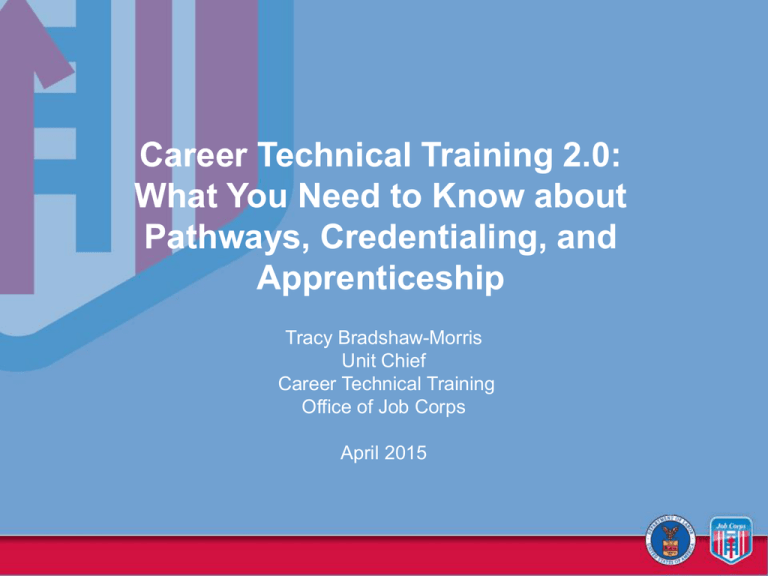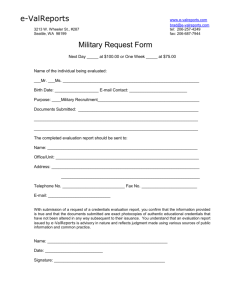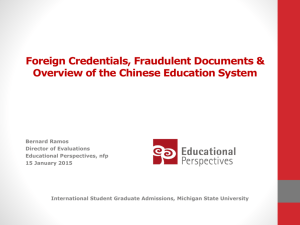Career Technical Training 2.0
advertisement

Career Technical Training 2.0: What You Need to Know about Pathways, Credentialing, and Apprenticeship Tracy Bradshaw-Morris Unit Chief Career Technical Training Office of Job Corps April 2015 A Main Goal of WIOA Providing workforce investment activities, through workforce development systems, that increase employment, retention, and earnings of participants and that increase post-secondary credential attainment and, as a result, improve the quality of the workforce, reduce dependency, increase economic selfsufficiency, meet skill requirements of employers, and enhance productivity and competitiveness of the nation. WIOA Aligns Systems WIOA Drives CTT Initiatives Workforce Investment Economic Development Education Job Corps Career Technical Training Initiatives: 2015-2017 • Career Pathways • Credential Attainment/ Stackable Credentials • Pre-Apprenticeship Priority #1: Career Pathways CAREER PATHWAY.—The term ‘‘career pathway’’ means a combination of rigorous and high-quality education, training, and other services that— (A) aligns with the skill needs of industries (B) prepares for education options (C) includes counseling (D) incorporates concurrent education (E) accelerates educational and career advancement (F) enables attainment of a secondary school diploma and at least 1 recognized postsecondary credential; and (G) helps an individual enter or advance within a specific occupation or occupational cluster. WIOA: Title I, Sec. 3(7)(A-G) We are Ready! Definition of Career Pathways in ETA/Job Corps: A series of related education, career technical and career success “skill building” opportunities that enable students to gain employment in specific occupations within a high-growth industry sector and to advance to higher levels of education and employment in that sector or other related fields. Job Corps Aligns with DOL/ETA Competency Models • Occupational • • • • TARs Industry-Based Certifications State Licenses Apprenticeship • Industry-Related • Foundation Courses • Foundational • Academic/Applied Academic Standards • HSD/HSE Diploma • Career Success Standards 6 11 Targeted Industries • • • • • • • • • • • Advanced Manufacturing Automotive and Machine Repair Construction* Finance and Business* Health Care* Homeland Security Hospitality Information Technology Renewable Resources and Energy Retail Sales and Service Transportation All Industries have Multiple Career Pathways Health Care DIRECT PATIENT CARE DIAGNOSTIC/ THERAPEUTIC HEALTH INFORMATICS Directors of Nursing $30 - $50 Hourly Medical and Clinical Lab Technicians; Dietitians $25 - $35 Hourly Systems Analysts; Business Office Managers $25 - $35 Hourly ASSOCIATE DEGREE (2 Year) RNs; Physical and Occupational Therapists $25 - $35 Hourly Medical and Clinical Lab Technicians; Dental Hygienists $20 - $30 Hourly Executive Assistants $15 – $25 Hourly I Year or Less Training Nurse Assistants; EMTs; Medical Assistants; LPVN $12 - $18 Hourly Dental Assistants; Phlebotomists $15 - $20 Hourly Electronic Medical Records Clerks $12 - $18 Hourly Physical Therapist Aides; ER Technicians $12 - $18 Hourly Pharmacy Technicians; Home Health Aides $10 - $15 Hourly Bookkeepers; Medical Receptionists $15 - $20 Hourly BA/BS (University – 4 Year) HIGH SCHOOL OR EQUIVALENT Sample Health Care Pathway Direct Patient Care Bachelor of Science in Nursing Progressive Learning Registered Nurse RN State Licensure Licensed Practical Nurse LPN State Licensure EEKG Technician NHA EKG Industry Certification Clinical Medical Assistant NHA CCMA Industry Certification Foundation Skills/Academics High School Diploma/ CPR/First Aid WAGES Job Corps as Part of the Broader Career Pathway System LOCAL, STATE AND REGIONAL CAREER PATHWAYS IN TARGETED GROWTH INDUSTRY SECTORS High Schools JOB CORPS Community Colleges REGIONAL CAREER PATHWAY PLANS Registered Apprenticeship Workforce Boards Business Partnerships Economic Development Community-Based Organizations Regional Pathway Plans: Launched 2009-2011 • Provided basis for a national (region-specific) approach to career pathway development • Served as a framework for decision making around center offerings. • Served as a mechanism of requesting funds for: - CTT program changes - Modernization - Staff training for instructor certification Priority #2:Credentials • Align Programs with Credentials as a Validation of knowledge and skills • Several major types of credentials • • • • Education (HSD/HSE, College Certificate/Degree) Industry-Based Certifications State Licenses Registered Apprenticeships/Pre-Apprenticeship • Some require both knowledge and performance assessments to demonstrate mastery WIOA Requirement • WIOA places new emphasis on credentials, post-secondary education and training for in-demand industry sectors and occupations • Good news: Job Corps was among the first employment and training system in the country to align ALL of its CTT programs to industry credentials (launched in 2006). Credential Attainment What’s Important? • Not all credentials are created equal. • Need for continuous improvement /refinement of the credential approval process and credential attainment tracking. • Data supports emphasis on primary credential attainment for improved placement results and higher wage impact. New Directions • Emphasize “stackable” credentials. • Sort and label credentials by a “primary” and “secondary” classification. • Revise PRH policy to reflect third party proctor testing process. • Explore digital badging capabilities. Projected Impact • Create a system that acknowledges credential attainment fairly and accurately and supports full range of student abilities. • Ensure Job Corps graduates leave with employer-recognized, industry-driven credentials valued by employers. • Emphasize “stackable” credentials. • Phase in approach for minimal disruption on the system. • Align policy with practice. Priority #3: Registered Apprenticeship Pilot Programs What’s Important? • Current low apprenticeship placement outcomes. • Complies with President’s and Secretary’s goals. • Offers greater employment opportunities and higher wages for Job Corps graduates. • New WIOA requirement: Section 153. New Directions Pilot Programs: • Culinary Arts (Hospitality) with American Culinary Federation Education Foundation (ACFEF) • Machining and Manufacturing Technology (Advanced Manufacturing) with National Institute for Metalworking Skills (NIMS) • Pharmacy Technician (Health Care) with CVS Pharmacy. Projected Impact • Pilot new programs from 1 to 3 years. • 22 Pilot Centers and approximately 46+ students. • Increase registered apprenticeship placements. • Based on outcome, roll-out or expand registered apprenticeship programs system-wide. Leveraging Technology: CTT Change Request Process What’s Important? • Voluminous paper-based submittals. • Irregular frequency of submissions. • Administrative burden on regional and national office staff resources. • Inconsistent with Regional Career Pathway strategies. New Directions • Simplify and automate current submission, review, and approval process. • Move to a quarterly, bi-annual and annual submission/review/approval process. • Connects funding availability to implementation. • Support career pathway planning. Projected Impact A comprehensive July 1 implementation across program activities supports four critical elements: 1. Accurate data alignment in CIS-3G; 2. Stronger career pathways planning; 3. Best use of staff resources at center, regional and national levels; and, 4. Improved funding investments and accountability. Timeline Phased-in Implementation PY 15-17 • Reintroduce Regional Career Pathway Plans. • Fine-tune Credential Attainment • Implement 3rd Party Proctor Credential Testing. • Categorize Credentials as Primary and Secondary. • Determine Revised Credential Measures • Institute Automated CTT Change Request and Quarterly Review and Approval Process. • Stand-up of Apprenticeship Pilot Programs. Overall Projected Impact • Streamlines and improves major CTT activities. • Creates a positive impact system-wide. • Fosters progress using technology and innovation. • Enhances Job Corps students’ education and training experience and improves placement and wage outcomes. • Responds to new WIOA legislation requirements. Resources • WIOA - http://www.doleta.gov/wioa/ • DOL/ETA - http://www.doleta.gov/ • Office of Apprenticeship http://www.dol.gov/apprenticeship/ • Career OneStop Competency Models http://www.careeronestop.org/Competency Model/ • My Next Move https://www.mynextmove.org/ Resources, continued… Digital Badging: • What is Digital Badging? (MacArthur Foundation) http://www.macfound.org/programs/digital-badges/ • Things You Should Know About Badging (Educause) http://net.educause.edu/ir/library/pdf/eli7085.pdf • National Retail Federation Foundation Digital Badging FAQs - https://nrf.com/careercenter/certifications-and-training/digital-badges Questions Tracy Bradshaw-Morris Career Technical Training Unit Chief Office of Job Corps (202) 693-8000 bradshaw-morris.tracy@dol.gov


